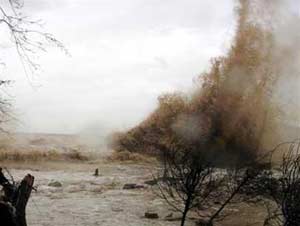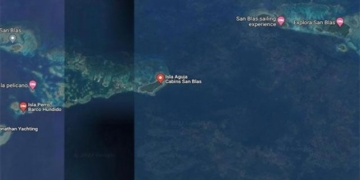Scientists around the world have raised alarms about the increasing global temperatures, warning that if nations do not take decisive actions, the consequences could be unimaginable.
 |
Severe storms accompanied by rising sea levels are consequences of global warming (image of Typhoon No. 7 in 2005) |
In an interview with Tuổi Trẻ, Mr. Lê Nguyên Tường, head of the Science, Training, and International Cooperation Department at the Meteorology and Hydrology Institute, stated:
– The majority of greenhouse gases are natural gases that have existed for a long time and are important components of the atmosphere. These gases are capable of emitting and reflecting long-wave solar radiation, and they are referred to as greenhouse gases.
Thanks to the stable concentrations of greenhouse gases in the atmosphere, the Earth’s climate has warmed to its current state, supporting a diverse range of life forms. The average surface temperature of the Earth is about 15oC.
However, with the advancement of science and technology, economic development, and especially the industrial revolution, humans have added a massive volume of artificial greenhouse gases to the atmosphere, significantly altering the concentration of greenhouse gases and changing the atmosphere’s ability to absorb and reflect radiation, thereby enhancing the greenhouse effect. The inevitable consequence is an increase in the Earth’s surface temperature.
How will global temperatures be forecasted to rise in the near future, sir?
– The latest studies and calculations from the Intergovernmental Panel on Climate Change indicate that by 2100, the Earth’s surface temperature could increase by 1.4 to 5.8oC. Land temperatures are rising faster than sea temperatures, and the Northern Hemisphere is warming more than the Southern Hemisphere. It is predicted that by 2100, due to rising temperatures, sea levels could rise between 9 and 88 cm.
There are significant differences in these calculations due to the complexities of interactions within the climate system and the components affecting it. However, the changes are certain. Even the smallest changes are issues that require attention.
In Vietnam, the average annual temperature is trending to rise by about 0.1oC per decade. The average temperature in some summer months is increasing by about 0.1 to 0.3oC per decade. It is anticipated that in the future, inland regions will experience more significant temperature changes compared to coastal regions.
What consequences will occur as global temperatures rise?
– Vietnam is situated in a disaster-prone area, so the consequences of rising global temperatures will directly impact Vietnam through increased frequency and intensity of natural disasters. Additionally, with over 3,000 km of coastline and more than 3,000 islands, Vietnam will face severe impacts from rising sea levels.
Millions of hectares in the Mekong Delta and Red River Delta could be submerged, with hundreds of thousands of hectares of mangrove forests lost. The living conditions, daily lives, and infrastructure of coastal residents will deteriorate.
As sea temperatures rise, economically significant fish species that inhabit temperate regions may migrate to higher latitudes or deeper waters. It is forecasted that due to rising temperatures, fish stocks in our fishing grounds could decline by one-third compared to current levels.
Climate change also severely affects human health. Human health will be negatively impacted, with increased risks of disease outbreaks, weakened immune systems, and the development of disease carriers, potentially leading to the resurgence of previously controlled diseases such as malaria and dengue fever.
How are countries worldwide and Vietnam responding to this situation, sir?
– The United Nations Framework Convention on Climate Change is a vital collective effort by the international community to limit and control artificial greenhouse gas emissions.
Along with reducing greenhouse gas emissions, it is crucial that we seek adaptation measures for global warming and climate change. Several research projects on climate change adaptation have been implemented in the Central region, an area frequently affected by floods, droughts, and natural disasters.
These projects focus on developing specific measures for communities and villages to adapt and respond to natural disasters, such as constructing access routes for evacuation during floods, establishing schools in accessible locations for people to gather, and raising awareness about disaster prevention among local leaders and ordinary citizens so that climate change considerations are integrated into infrastructure planning…
Another important measure is reforestation to mitigate flooding and landslides in mountainous areas.
KHIẾT HƯNG reported



















































